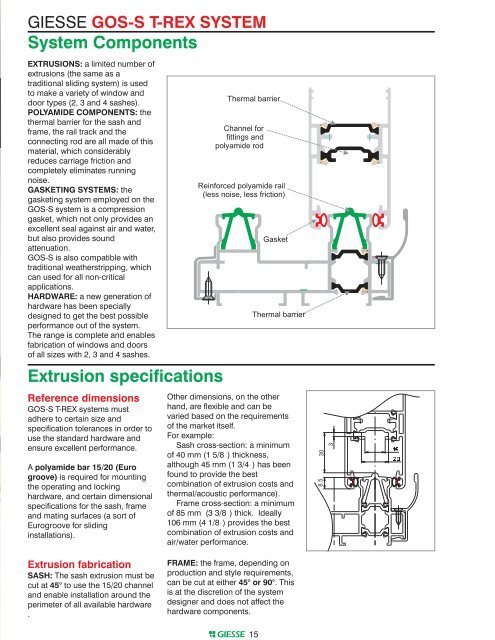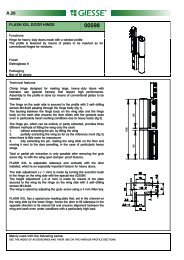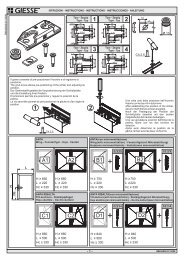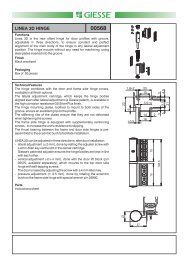You also want an ePaper? Increase the reach of your titles
YUMPU automatically turns print PDFs into web optimized ePapers that Google loves.
<strong>GIESSE</strong> <strong>GOS</strong>-S T-<strong>REX</strong> <strong>SYSTEM</strong><br />
System Components<br />
EXTRUSIONS: a limited number of<br />
extrusions (the same as a<br />
traditional sliding system) is used<br />
to make a variety of window and<br />
door types (2, 3 and 4 sashes).<br />
POLYAMIDE COMPONENTS: the<br />
thermal barrier for the sash and<br />
frame, the rail track and the<br />
connecting rod are all made of this<br />
material, which considerably<br />
reduces carriage friction and<br />
completely eliminates running<br />
noise.<br />
GASKETING <strong>SYSTEM</strong>S: the<br />
gasketing system employed on the<br />
<strong>GOS</strong>-S system is a compression<br />
gasket, which not only provides an<br />
excellent seal against air and water,<br />
but also provides sound<br />
attenuation.<br />
<strong>GOS</strong>-S is also compatible with<br />
traditional weatherstripping, which<br />
can used for all non-critical<br />
applications.<br />
HARDWARE: a new generation of<br />
hardware has been specially<br />
designed to get the best possible<br />
performance out of the system.<br />
The range is complete and enables<br />
fabrication of windows and doors<br />
of all sizes with 2, 3 and 4 sashes.<br />
Extrusion specifications<br />
Reference dimensions<br />
<strong>GOS</strong>-S T-<strong>REX</strong> systems must<br />
adhere to certain size and<br />
specification tolerances in order to<br />
use the standard hardware and<br />
ensure excellent performance.<br />
A polyamide bar 15/20 (Euro<br />
groove) is required for mounting<br />
the operating and locking<br />
hardware, and certain dimensional<br />
specifications for the sash, frame<br />
and mating surfaces (a sort of<br />
Eurogroove for sliding<br />
installations).<br />
Extrusion fabrication<br />
SASH: The sash extrusion must be<br />
cut at 45° to use the 15/20 channel<br />
and enable installation around the<br />
perimeter of all available hardware<br />
.<br />
Thermal barrier<br />
Channel for<br />
fittings and<br />
polyamide rod<br />
Reinforced polyamide rail<br />
(less noise, less friction)<br />
Gasket<br />
Thermal barrier<br />
Other dimensions, on the other<br />
hand, are flexible and can be<br />
varied based on the requirements<br />
of the market itself.<br />
For example:<br />
Sash cross-section: a minimum<br />
of 40 mm (1 5/8 ) thickness,<br />
although 45 mm (1 3/4 ) has been<br />
found to provide the best<br />
combination of extrusion costs and<br />
thermal/acoustic performance).<br />
Frame cross-section: a minimum<br />
of 85 mm (3 3/8 ) thick. Ideally<br />
106 mm (4 1/8 ) provides the best<br />
combination of extrusion costs and<br />
air/water performance.<br />
FRAME: the frame, depending on<br />
production and style requirements,<br />
can be cut at either 45° or 90° . This<br />
is at the discretion of the system<br />
designer and does not affect the<br />
hardware components.<br />
15<br />
15<br />
20












